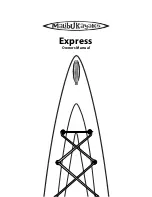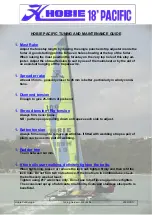
exceeds the standards of the USCG, ABYC and the NMMA.
Some required safety equipment, such as life jackets (PFDs), are
not included with your boat. Your dealer can help you choose the
appropriate equipment.
Many states’ equipment requirements
go beyond USCG requirements.
Contact your state boating office for
further information.
Operation by Minors and Licensing
If your boat will be operated by a minor, remember to have an
adult present at all times. Many states have laws regarding minimum
age and licensing requirements for minors.
Some states require boat training courses, certification, or
licensing for minors and/or adults. Contact state and local authorities
for requirements that apply in your area.
Your boat and equipment must be in compliance with federal,
state and local safety equipment regulations. USCG regulations
require certain safety equipment be present on your boat during
Safety—5
Boat smart from the start: Take a boating safety course and get a
free vessel safety check annually for your boat. For more information,
contact: United States Coast Guard Auxiliary, www.cgaux.org; United
States Power Squadrons, 1-888-FOR-USPS, www.usps.org.
The following is a list of some other agencies and organizations
that offer Water Safety, First Aid and CPR courses or information. To
find boating safety courses in your area, call your state’s local boating
agency or the USCG boating safety course line at 1-800-336-2628 (1-
800-245-2628 in Virginia).
• USCG Office of Boating (www.uscgboating.org)
• American Red Cross ( www.redcross.org )
• U.S. Coast Guard Auxiliary (www.cgaux.org)
• U.S. Power Squadrons (www.usps.org)
• State Boating Offices
• Canadian Power and Sail Squadrons (www.cps-ecp.ca)
• Boat Owners Association of the United States
(www.boatus.com)
• National Safe Boating Council (www.safeboatingcouncil.org)
• Water Sports Industry Association (www.wsia.net)
• European or international organizations
operation. For a detailed description, obtain “Federal Requirements
for Recreational Boats” published by the U.S. Coast Guard and
available online at:
http://www.uscgboating.org/images/420.PDF
In addition to the USCG regulations, other local and/or international
law enforcement agencies may have similar requirements. You
should check with your local marine law enforcement agency
regarding any such requirements before boating.
SAFETY AND REQUIRED EQUIPMENT
Equipment requirements for coastal and inland waters differ.
Check with local authorities and/or the USCG for further information
about coastal water requirements.
The Federal Boat Safety Act of 1971 (FBSA/71) and the National
Recreation Boating Safety Program have established minimum safety
standards for boats and associated equipment, specified by the
USCG. In addition, the American Boat and Yacht Council (ABYC) and
the National Marine Manufacturers Association (NMMA) work with
boat builders to develop voluntary standards that exceed the USCG
requirements. The included safety equipment on your boat meets or
Navigation Lights
Your boat is equipped with navigational lights. Recreational
boats are required to display navigational lights between sunset
and sunrise and other periods of reduced visibility (fog, rain, haze,
etc.). Navigation lights are provided to keep other boats informed
of your presence and course. It is up to you to make sure they are
operational, displayed correctly, and turned on when required.
Emergency Safety Stop Switch
Your boat is equipped with an Emergency Safety Lanyard
(cutoff switch). We recommend that the lanyard be secured to the
operator and the lock plate attached to the emergency cutoff switch
prior to starting the engine and anytime the engine is operating.
The Emergency Safety Lanyard is designed to turn off the engine
whenever the operator moves far enough away from the helm to
activate the switch. The
purpose is to stop the
engine, propeller, and
boat in the event the
operator leaves the helm
location, falls overboard,
or is ejected from the
boat. If the engine is
stopped it will prevent
the boat from becoming a run-away, unmanned boat, which may
cause injury or death to boat occupants who have fallen overboard
or been ejected, or to other nearby people. If the engine stops it will
minimize the subsequent opportunity for propeller contact with the
operator or other persons in the water. If the engine and boat stop it
will afford opportunity for the operator or other persons who have
fallen overboard to safely re-board the boat.
It is required that you use the
Emergency Safety Lanyard system
as failure to do so can cause death or
serious injury. DO NOT operate the boat if the Emergency Safety
Lanyard system does not function properly.














































